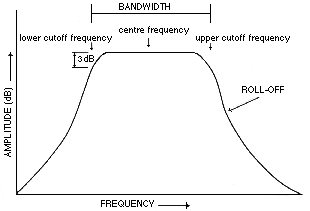An electrical device used to affect certain parts of the SPECTRUM of a sound, by causing the ATTENUATION of certain frequency BANDs, while allowing other bands to pass unattenuated. Some common types of filters are:
- high-pass filters (which attenuate low frequencies below the cut-off frequency);
- low-pass filters (which attenuate high frequencies above the cut-off frequency);
- band-pass filters (which combine both high-pass and low-pass functions as in the diagram below);
- band-reject filters (which perform the opposite function of the band-pass type);
- octave, half-octave, third-octave, tenth-octave filters (which pass a controllable amount of the spectrum in each band);
- shelving filters (which boost or attenuate all frequencies above or below the shelf point);
- resonant or FORMANT filters (with variable centre frequency and Q).
A group of such filters may be interconnected to form a filter bank.
See: COMB FILTER, EQUALIZATION, MASS, SOUND ANALYSER. For the use of filters in ELECTRONIC MUSIC, see MUSIQUE CONCRETE, SOUND SYNTHESIS, SOUND SYNTHESIZER.
The BANDWIDTH of the spectrum which is passed unattenuated depends on the cut-off frequency, that is, the lowest or highest frequency attenuated less than 3 dB. For an ideal filter, the attenuation for frequencies beyond the cut-off would be complete, but in practice each filter has a gradual reduction, or roll-off, which is measured as the rate of attenuation for frequencies beyond the cut-off, in decibels/octave (6 dB/octave is considered minimally acceptable). The unattenuated range of a filter is called its passband.
The Q of a bandpass filter is a measure of its RESONANCE and is defined as the ratio of CENTRE FREQUENCY to the bandwidth. The narrower the bandwidth, the higher the Q, and the more the filter will 'ring' or go into oscillation when stimulated by a signal with energy near the centre frequency. A constant Q filter varies its bandwidth as a function of the centre frequency, always keeping the ratio between them the same. Compare: CRITICAL BANDWIDTH.

Generalized response characteristic of a band-pass filter. A low-pass filter includes only an upper cut-off, and a high-pass filter only a lower cut-off frequency. A band-reject filter has the inverse characteristic of that shown.
![]() Sound
Example: Four examples of filtered
white
noise:
Sound
Example: Four examples of filtered
white
noise:
- low-pass filtered with a cutoff of 1 kHz
- high-pass filtered with a cutoff of 1 kHz
- band-pass filtered with a centre frequency of 1 kHz
- band-reject filtered with a centre frequency of 1 kHz
home